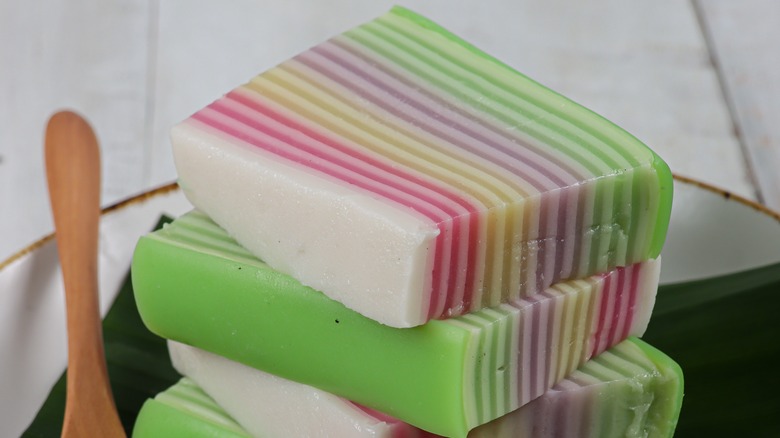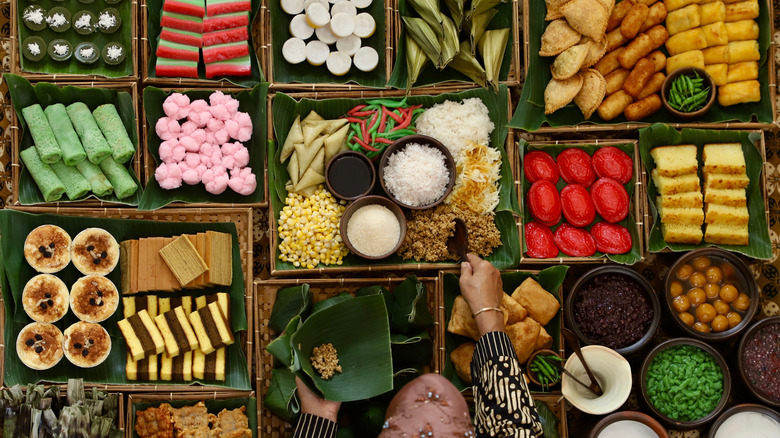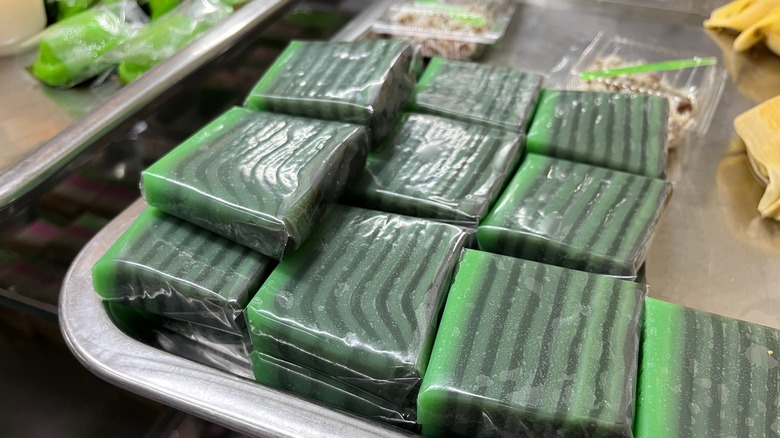Kue Lapis Is The Indonesian Layer Cake With Incredible Textures
You're in a bustling restaurant in the heart of Jakarta, amid a symphony of sizzling satays, aromatic spices and rice, and vibrant noodle dishes — and an intriguing dessert draws your attention. Is it cake? Yes, but not just any cake: It's a tricolor pink, green, and white spectacle with multiple distinct layers, each meticulously stacked on the other.
This culinary masterpiece you're about to relish is kue lapis, Indonesia's iconic layered cake. Whether you gently peel each layer away or pierce it with a fork, this visual marvel reveals an even more extraordinary dance of flavors and textures. The cake's texture exhibits the sought-after quality of "Q" or "QQ" as it is known in Taiwan — a term denoting a certain springiness or bounciness akin to what al dente is to pasta. It's a unique chewiness that lends the kue lapis an irresistibly playful and toothsome mouthfeel.
The flavors are just as captivating. Delicate yet profoundly aromatic, each not-too-sweet bite brings a balanced blend of subtlety and flavor. This harmony of taste is thanks to the unmistakable hint of coconut and pandan, infusing each layer with a fragrant undertone that ties everything together. It's no wonder kue lapis is one of Indonesia's most iconic cakes and a vibrant embodiment of its rich culinary heritage. And while originating in Indonesia, kue lapis is popular and has variants across Southeast and East Asia — all of which are worth a taste, should you have the opportunity.
The colorful history and origins of kue lapis
More than a dessert, kue lapis is a piece of living history. We can trace the origins of this layered wonder of a cake back to colonization and cultural exchanges. When Dutch colonialists reached Indonesia in the late 1500s, they brought a version of German baumkuchen, a layered cake that likely inspired the initial concept of kue lapis. The term "lapis" in Indonesian refers to "layers," while "kue" denotes "cake," illustrating the dessert's key characteristic.
Subsequently, the Peranakan or Straits Chinese community in Indonesia — a group known for their unique fusion of Chinese, Malay, and Indonesian cultures — likely instilled the practice of steaming kue lapis. Steaming, as a culinary technique in general, swiftly integrated into the broader Indonesian culinary practices, thus making kue lapis a staple during festive celebrations like the Lunar New Year and Ramadan. Beyond its aesthetically pleasing appearance, kue lapis carries significant symbolism. The nine layers embody auspiciousness in Chinese culture, symbolizing longevity and blessings. (Nine in Chinese sounds like "long," for long life.)
From its Indonesian birthplace, kue lapis has journeyed across Southeast and East Asia, earning recognition, adaptation, and evolution. Today, it enjoys popularity across Malaysia, Singapore, China, and Asian diasporas, known by various names with unique spins but loved universally for its delightful layers and symbolic richness.
The art of making kue lapis
Crafting kue lapis is an exercise in culinary patience and precision, so it may not be the best recipe for the time-poor and impatient. At the heart of this masterpiece are simple ingredients — rice flour, tapioca flour, coconut milk, and sugar. You'll blend these base ingredients carefully into a smooth, even batter; then, divide and assign this batter different colors. (When a layer is green, the flavor is usually pandan.)
To make the signature layers of this cake, use a spoon or ladle and add some batter to a container and let it steam. This is the foundation or base layer of the kue lapis. Once this first layer is set, add more batter (of a different color) onto the base. These steps are repeated, steaming each layer separately, which requires time and precision. Take care to ensure uniform thickness and texture across all layers. Post-steaming, you'll cool the wobbly cake. Refrigeration then helps firm the layers, accentuating the cake's QQ or "bouncy" texture.
Regarding decoration, kue lapis often maintains a minimalist approach, allowing the vibrant and colorful layers to shine. To showcase its captivating interior, slice the cake before serving.
Variations and serving kue lapis
How you enjoy kue lapis is a personal affair — you can eat it chilled or at room temperature. Some find joy in the methodical peeling and savoring of each distinct layer, while others prefer an amalgamation of flavors, textures, and colors in one big bite. Have it with hot tea or coffee; kue lapis is a delightful teatime treat.
The enduring appeal of kue lapis lies in its versatility. Variations can be as simple as a change in color — using food coloring or natural colorants like beetroot, butterfly pea flower, or turmeric — or as complex as a shift in flavor profile by adding local spices like cardamom and cinnamon. In Asian diasporas, it's common to see rainbow-colored kue lapis. The rich, aromatic kue lapis legit is a baked counterpart brimming with butter, eggs, and spices. There's also the kue lapis surabaya, a yellow and brown Indonesian spongecake.
Regardless of the variation or the serving style, each slice of kue lapis is a vibrant tale of tradition, adaptation, and culinary evolution. As you savor kue lapis, you're not merely enjoying a dessert — you're immersing in a piece of Indonesian history and culture, one colorful and delicious layer at a time.



